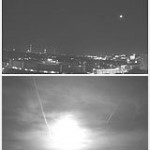Category Science & Technology
Earth Day events honor birth of environmentalism
For some of us it seems like just yesterday, but Earth Day turns 40 this year. The first Earth Day was held on April 22, 1970. Some 20 million people participated in environmental teach-ins across the United States. The event’s founder, U.S. Sen. Gaylord Nelson of Wisconsin, took a page from the antiwar movement to educate people about the environment and to put the cause on the national agenda.
Meteor fragment lands in UW–Madison geoscience department
Researchers in the University of Wisconsin–Madison Department of Geoscience had the opportunity Friday morning to analyze a rock fragment they believe is from the meteor that blazed through the skies over parts of Wisconsin and Iowa Wednesday night.
Recent sightings: Nighttime fireball
Moments before bursting in a dazzling fireball over southwestern Wisconsin, a likely meteor appears as a bright dot in the Wednesday night sky. This…
Stem cell symposium to focus on hurdles in stem cell therapy development
The fifth annual Wisconsin Stem Cell Symposium, called "The Road to Stem Cell Applications: Bioprocessing, Safety and Preclinical Evaluation," will be held on Wednesday, April 21 just outside of Madison.
CAREER Award funds study of how estrogen-mimics affect cells
An intricate biochemical messaging network, the endocrine system enables human bodies to grow and function properly throughout their lives.
Astronaut, in Madison visit, to discuss NASA’s changing plans
Former astronaut Harrison Schmitt, one of the last people to walk on the moon, will present a forceful case for manned space exploration in a talk at the University of Wisconsin–Madison on Monday, April 19.
Symposium honors long-time development and evolution researcher
The biologists gathering on the University of Wisconsin–Madison campus this Thursday, April 15, have one thing in common beyond their scientific interests in evolution and animal development.
As honeybee colonies collapse, can native bees handle pollination?
With colony collapse disorder continuing to plague commercial beekeepers in many parts of the country, University of Wisconsin–Madison experts are studying whether native pollinators can supply the insect pollination needed to form many fruits.
Controls for animals’ color designs revealed
The vivid colors and designs animals use to interact with their environments have awed and inspired since before people learned to draw on the cave wall.
UW-Madison student wins $250,000 fellowship
Daniel Lecoanet, who will graduate with comprehensive honors from University of Wisconsin–Madison this spring with a double major in math and physics, has won a five-year, no-strings-attached fellowship to pursue graduate studies.
From spinning atoms to blazing stars, Science Expeditions covers all bases
If there is any way to take in the full depth and breadth of the science being practiced and developed at the University of Wisconsin–Madison, the eighth annual Science Expeditions celebration is the way to do it.
On slippery science subjects, Internet news delivers
Internet-based science news draws a more demographically diverse, learned and focused audience than print or television news, according to a study by University of Wisconsin–Madison communication researchers.
Particle accelerator ready to attempt record-breaking collisions
Energy is building at the Large Hadron Collider outside of Geneva, Switzerland, in more ways than one.
Molecular biologist receives Stephen Jay Gould Prize
Sean Carroll, a University of Wisconsin–Madison molecular biologist and a Howard Hughes Medical Institute investigator, has been named the recipient of the 2010 Stephen Jay Gould Prize, an award given in recognition of exemplary efforts to advance public understanding of evolutionary science.
Study explores link between sunlight, multiple sclerosis
For more than 30 years, scientists have known that multiple sclerosis (MS) is much more common in higher latitudes than in the tropics. Because sunlight is more abundant near the equator, many researchers have wondered if the high levels of vitamin D engendered by sunlight could explain this unusual pattern of prevalence.
Twenty-year study yields precise model of tectonic-plate movements
A new model of the Earth, 20 years in the making, describes a dynamic three-dimensional puzzle of planetary proportions.
Engineers revolutionizing Third World housing and infrastructure featured at WARF Gilson event
The recent earthquake in Haiti graphically demonstrated to the world how the impact of a natural disaster is magnified by poorly constructed housing and unplanned infrastructure.
Book, research sparked professor’s passion for the gas and dust of the galaxy
Most people first think of the stars when thinking about outer space — but Snezana Stanimirovic is more interested in what’s between them.
From raw biomass, chemical process produces simple, fermentable sugars
A University of Wisconsin–Madison research team has developed a promising new chemical method to liberate the sugar molecules trapped inside inedible plant biomass, a key step in the creation of cellulosic biofuels.
Where the invasive things are — and where they could be
Researchers at the University of Wisconsin–Madison's Center for Limnology have launched a new Web site to help assess the threat of aquatic invasive species in Wisconsin's lakes.





